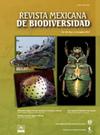墨西哥中部狭足虫复合体的线粒体基因组特征和线粒体基因组系统发育学(直翅目:狭足虫科:狭足目)
IF 0.8
4区 环境科学与生态学
Q4 BIODIVERSITY CONSERVATION
引用次数: 1
摘要
狭足类talpa物种群(狭足类)包括分布在跨墨西哥火山带(TMVB)形态构造省和墨西哥中部邻近地区的蟋蟀类直翅目昆虫。尽管最近做出了努力,但该复合体成员的分类学和进化关系仍远未完全为人所知。在这里,我们生成并表征了14个S.talpa物种组标本的线粒体(mt)基因组,并用cox1条形码基因座评估了其物种极限。此外,基于mt基因组DNA序列数据,我们还重建了其系统发育关系,并基于松弛的分子钟分析对其生物地理历史进行了推断。使用2%的成对距离标准对总共9个物种进行了界定,这与我们对系统发育的最佳估计一致。虽然与之前的系统发育研究相比,最近的分化时间估计更为准确,但塔尔帕S.talpa物种群恢复的关系相似,这表明其起源和随后在TMVB中的多样化遵循中东模式,其最早的分化发生在上新世晚期至更新世早期。本文章由计算机程序翻译,如有差异,请以英文原文为准。
Mitochondrial genome characterization and mitogenome phylogenetics in the central Mexican Stenopelmatus talpa complex (Orthoptera: Stenopelmatidae: Stenopelmatini)
The Stenopelmatus talpa species-group (Stenopelmatidae) comprises cricket-like orthopterans distributed across the Trans-Mexican Volcanic Belt (TMVB) morphotectonic province and adjacent areas in central Mexico. Despite recent efforts, the taxonomy and evolutionary relationships for members of this complex still are far from completely known. Here we generated and characterized the mitochondrial (mt) genome of 14 specimens of the S. talpa species-group and evaluated its species limits with the cox1 barcoding locus. Moreover, based on the mt genome DNA sequence data, we also reconstructed its phylogenetic relationships and made inferences about its biogeographic history based on a relaxed molecular clock analysis. A total of 9 species were delimited using a 2% pairwise distance criterion, which were consistent with our best estimate of phylogeny. The relationships recovered for the S. talpa species-group were similar although with more recent divergence time estimates than those obtained in a previous phylogenetic study, suggesting that its origin and subsequent diversification in the TMVB followed an east-central pattern, with its earliest divergence occurring during the late Pliocene to early Pleistocene.
求助全文
通过发布文献求助,成功后即可免费获取论文全文。
去求助
来源期刊

Revista Mexicana de Biodiversidad
环境科学-生物多样性保护
CiteScore
1.50
自引率
11.10%
发文量
69
审稿时长
12-24 weeks
期刊介绍:
Revista Mexicana de Biodiversidad appears in 4 issues per year and publishes the products of original scientific research regarding biodiversity of the Americas (systematics, biogeography, ecology and evolution), as well as its conservation and management.
The journal ensures high standards with a system of external peer review, and is included in the list of excellence of journals of the National Council of Science and Technology (CONACyT, Mexico). It is currently included in ASFA, Biological Abstracts, Biological Sciences, Latindex Periódica, RedALyC, Web of Science (Thomson Reuters), SciELO, SCOPUS, and Zoological Records.
 求助内容:
求助内容: 应助结果提醒方式:
应助结果提醒方式:


